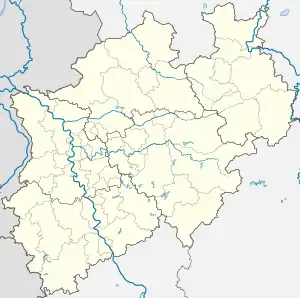Grevenbroich | ||||||||||||||||||||||||
|---|---|---|---|---|---|---|---|---|---|---|---|---|---|---|---|---|---|---|---|---|---|---|---|---|
| Through station | ||||||||||||||||||||||||
 Entrance from the station forecourt (April 2007) | ||||||||||||||||||||||||
| General information | ||||||||||||||||||||||||
| Location | Bahnhofsvorplatz 17, Grevenbroich, North Rhine-Westphalia Germany | |||||||||||||||||||||||
| Coordinates | 51°5′35″N 6°34′50″E / 51.09306°N 6.58056°E | |||||||||||||||||||||||
| Line(s) | ||||||||||||||||||||||||
| Platforms | 4 | |||||||||||||||||||||||
| Other information | ||||||||||||||||||||||||
| Station code | 2263[1] | |||||||||||||||||||||||
| DS100 code | KGRB[2] | |||||||||||||||||||||||
| IBNR | 8000133 | |||||||||||||||||||||||
| Category | 4[1] | |||||||||||||||||||||||
| Fare zone | ||||||||||||||||||||||||
| Website | www.bahnhof.de | |||||||||||||||||||||||
| History | ||||||||||||||||||||||||
| Opened | 1 September 1869[5] | |||||||||||||||||||||||
| Services | ||||||||||||||||||||||||
| ||||||||||||||||||||||||
| Location | ||||||||||||||||||||||||
 Grevenbroich Location within North Rhine-Westphalia | ||||||||||||||||||||||||
Grevenbroich station is a junction station in the city of Grevenbroich in the German state of North Rhine-Westphalia. It is located at the junction of the Cologne–Mönchengladbach railway and the Düren–Neuss railway. It is classified by Deutsche Bahn as a category 4 station.[1]
With stops by Busverkehr Rheinland (BVR, a bus operator owned by Deutsche Bahn) in the five bays of the bus station in the station forecourt, Grevenbroich station is the transport hub of Grevenbroich.
History
The first entrance building of Grevenbroich station was demolished after the Second World War, probably as a result of war damage. It was replaced by the existing station building.[5]
The area of the former goods yard, which lay to the west of the platforms, has been reduced dramatically in recent years, so that today it is no longer used. Only a large brownfield area indicates its former size.
With the commissioning of electronic interlocking at Grevenbroich on the Rheydt-Ehrenfeld route in 2007, the Gnf and Gs signal boxes were closed, but they still exist.[5]
The station was partially restored in the period from July to September 2012. A new floor covering with a tactile guidance system for the visually impaired and blind was installed and the entrance area was renovated. The middle entrance door was replaced by an automatically opening door, it allows wheelchair users and people with restricted mobility to enter the station. Deutsche Bahn invested about €300,000 for this project.
Operations
Grevenbroich station is served by the following three services:[6]
| Line | Line name | Route | Frequency |
|---|---|---|---|
| RE 8 | Rhein-Erft-Express | Mönchengladbach – Grevenbroich – Rommerskirchen – Cologne – Porz (Rhein) – Troisdorf – Bonn-Beuel – Linz (Rhein) – Neuwied – Koblenz Stadtmitte – Koblenz | Hourly |
| RB 27 | Rhein-Erft-Bahn | Mönchengladbach – Grevenbroich – Rommerskirchen – Cologne – Cologne/Bonn Airport – Troisdorf – Bonn-Beuel – Linz (Rhein) – Neuwied – Engers – Koblenz-Ehrenbreitstein – Koblenz | Hourly |
| RB 39 | Düssel-Erft-Bahn | Düsseldorf – Neuss – Grevenbroich – Bedburg (Erft) | Every 30 mins (Düsseldorf–Grevenbroich); every 60 mins (Grevenbroich–Bedburg (Erft)) |
Planning
There were plans to replace the former RB 38 service (which ran from Cologne to Düsseldorf via Horrem, Bedburg and Grevenbroich) by a new Rhine-Ruhr S-Bahn line S 18, which would have involved electrifying the Düren–Neuss railway through Grevenbroich station, although this plan is not currently being pursued for the section north of Bedburg. The section from Bedburg to Düsseldorf has been separated and now operates as the Düssel-Erft-Bahn, which has been renumbered as the RB 39.
Platform usage
In general, rail services use the platforms as follows:
| Platform | Line | Use |
|---|---|---|
| 1 | RE 8 RB 27 | to Mönchengladbach |
| 2 | RB 39 | to Düsseldorf, Bedburg (Horrem and Cologne until December 2017) |
| 3 | RB 39 | to Düsseldorf, Bedburg (Horrem and Cologne until December 2017) |
| 4 | RE 8 RB 27 | to Koblenz |
Bus routes
The station is served by the following bus routes operated by Busverkehr Rheinland:[6]
| Line | Route | Frequency |
|---|---|---|
| 869 | Neuss Stadthalle – Holzheim – Grevenbroich Kapellen – Wevelinghoven – Grevenbroich Bf | Every 60 or 120 minutes |
| 871 | Grevenbroich Bf – Rommerskirchen Vanikum – Rom. Postamt/Bf – Dormagen Delhoven – Dormagen Bf – Marktplatz/Cologne | Every 60 or 120 minutes |
| 877 | Neuss Landestheater – NE-Süd Bf – Holzheim – Grevenbroich Kapellen – Wevelinghoven (– Grevenbroich Bf) | Every 60 or 120 minutes |
| 879 | Neuss Stüttgen – Elvekum – Norf – Hoisten – Grevenbroich Neukirchen – Wevelinghoven (– Grevenbroich Bf) (small bus) | |
| 891 | Rommerskirchen − Grevenbroich Bf − Kapellen-Wevelinghoven Bf | Every 30 or 60 minutes |
| 892 | Gindorf – Gustorf – Grevenbroich Bf – Allrath – Rommerskirchen Oekoven – Evinghoven | Every 30 or 60 minutes |
| 893 | Kapellen-Wevelinghoven Bf – Wevelinghoven – Grevenbroich Bf | Every 60 minutes |
References
- 1 2 3 "Stationspreisliste 2024" [Station price list 2024] (PDF) (in German). DB Station&Service. 24 April 2023. Retrieved 29 November 2023.
- ↑ Eisenbahnatlas Deutschland (German railway atlas) (2009/2010 ed.). Schweers + Wall. 2009. ISBN 978-3-89494-139-0.
- ↑ "Fahrplan 2020: Neuss/Kaarst" (PDF). Verkehrsverbund Rhein-Ruhr. Stadtwerke Neuss. 7 January 2020. Retrieved 12 May 2020.
- ↑ "VRS-Gemeinschaftstarif" (PDF) (in German). Verkehrsverbund Rhein-Sieg. 20 April 2020. p. 201. Retrieved 9 May 2020.
- 1 2 3 "Grevenbroich operations". NRW Rail Archive (in German). André Joost. Retrieved 15 June 2013.
- 1 2 "Grevenbroich station". NRW Rail Archive (in German). André Joost. 15 June 2013.